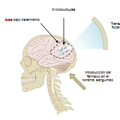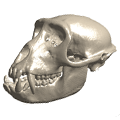Acoustic Fields in Transcranial Propagation for Ultrasound Induced Blood-Brain Barrier Opening

Ultrasound techniques are emerging for localized, transient and safe Blood-Brain Barrier opening allowing targeted and noninvasive brain drug delivery. When low amplitude transcranial focused ultrasound is employed the acoustic focal commonly exhibits changes in axial and radial location. My work in this line include numerical simulations of acoustic focused fields into the skull in order to control the spatial characteristics of the focal area, i.e. a better control of the targeting
Moreover, when finite amplitude waves are considered the focal location of a focused source can be shifted due to nonlinear acoustics effects. Thus, transcranial acoustic propagation is predicted by a numerical approach entailing nonlinear wave propagation in the time domain in order to determine the position of the peak pressure location. Typical setup parameter are transducers with a curvature radius of 90 mm, aperture of 80 mm and central frequency around 500 kHz.

The computational method was a Finite-Differences in Time-Domain (FDTD) implemented on nonlinear fluid model over a 2D Axis-symmetric domain. The boundary conditionswere derived from the apparent density measurements based on a 3D CT scan acquisition performed on a macaca mulatta primate. The nonlinear behavior of beam properties (full width at half maximum, peak pressure locations, effective gain and sonificated volume) has been studied. The results show that for small amplitude transcranial propagation shifts the peak pressure -5.1 mm from the geometrical focus. Simulated nonlinear propagation shifts the peak pressure location away from the transducer: shifted focus of +0.5 mm relative to the linear peak location for 0.5 MPa peak pressure and +0.9 mm for 4 MPa. For rarefaction peak pressure location a shift of -2.23 mm has been predicted. A variation of -7.2% in the sonificated volume covered by the beam has been observed for 0.5 MPa peak pressure. These results evidence that nonlinear propagation effects can slightly affect the ultrasound beam properties.